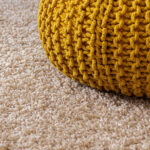Using a vacuum with strong suction
The best time to treat a carpet stain is as quickly as possible. For liquid spills, immediately blot away the moisture with paper towels or a white cloth. Never use a cloth or napkin that might not be colorfast
Most professional carpet cleaning services use a combination of detergents and steam to deep clean carpet and recommend cleaning at least once per year.
Always begin any cleaning process by vacuuming the carpet to remove loose soil, dust, dirt, and debris. If you skip this step, you may just be pushing soil around or driving it deeper into the fibers. Removing some stains like oil, tar, and pet accidents will require special treatment. Consult a stain removal chart for the proper cleaners to remove those stains.
In a spray bottle, mix one part of distilled white vinegar and three parts of cold water. You will need to refill the bottle several times if cleaning a wall-to-wall carpet.
WARNING
Before beginning the deep-cleaning process, spray the vinegar solution on the carpet in a hidden location to test the colorfastness of the carpet. Do not use the solution if you see any bleeding or change of color.
Working in a small 3-feet x 3-feet area, spray the vinegar solution onto the carpet until it’s very damp. Do not saturate. Follow a grid so you’ll know where you have cleaned. If you are cleaning an area rug, take extra precautions to protect the floor beneath the rug from moisture damage.
Allow the solution to remain on the carpet for five minutes to begin breaking down the soil. Use a microfiber cloth to blot away the solution and the soil. Have a bucket of clean water ready to rinse the microfiber cloth. Change the water frequently as it becomes soiled.
Open doors and windows to increase the airflow in the room or add oscillating fans to speed drying. Do not allow traffic on the carpet until it is fully dry.
If you must use the room while the carpet is damp, place plastic sheeting or tarps on the traffic pathways to prevent staining.
Use old towels or microfiber cloths to absorb the loosened soil. Allow the carpet to dry completely and vacuum to remove any residue remaining in the carpet.
Follow the same steps for mixing baking soda and salt. Sprinkle the carpet with the mixture and then use steam, instead of cold water, to dampen the mixture.
Vacuum the carpet to remove loose soil and pretreat stained areas.
If you have a clothes steamer or steam mop that is usually used on hard-surface floors, they can be used to deep clean carpet, as well.
After scrubbing, use old towels or rags to wipe away the loosened soil. It is fine to leave a bit of baking soda in the fibers. Allow the carpet to air-dry completely. Use a vacuum to remove any remaining baking soda left in the fibers. The carpet should smell fresher and look brighter.
Liberally sprinkle the carpet with the baking soda and salt mixture. You may find it easier to work in a grid pattern starting in a corner and working toward an exit.
After sprinkling, spritz the area with a spray bottle filled with plain water. The carpet should be very damp, but not sopping wet. Use a scrub brush to work the baking soda deeper into the carpet fibers. Go in one direction and then at a 90-degree angle to help lift the soil.
Vacuum or sweep the carpet to remove loose soil and then follow the recommendations on a stain removal chart to remove visible stains.
Vacuum or sweep the carpet to remove loose soil and then follow the recommendations on a stain removal chart to remove visible stains.

